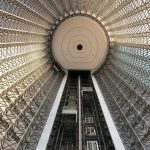Elevcon 2023, Hakonen won ʻHigh Tech Award Elevatori-Elevconʼ
During Elevcon 2023, the ʻHigh Tech Award Elevatori-Elevconʼ was awarded. The winner was the paper “Simulation Based Design of Transportation Systems in Buildings” written by Henri Hakonen (Lic.Sc. – Tech.), Juha-Matti Kuusinen (D.Sc. – Tech.), and Janne Sorsa (D.Sc. – Tech), from KONE Corporation, Finland. Henri Hakonen (pictured) accepted the award.
The ʻHigh Tech Award Elevatori-Elevconʼ is the prize for the best presentation of the congress: not an easy task given the very high technical and scientific level of the papers. The winner was selected by a prestigious jury made up of representatives of Elevconʼs scientific committee, including the president of the IAEE and Matteo Volpe (our editor).
The award was presented by Matteo Volpe, editor of Elevatori Magazine. The award committee was composed by Marja-Liisa Siikonen (Elevcon 2023 Chairwoman & Programme Manager), Matteo Volpe, Seiji Watanabe, Ivan Bozic and Pascal Rebillard.
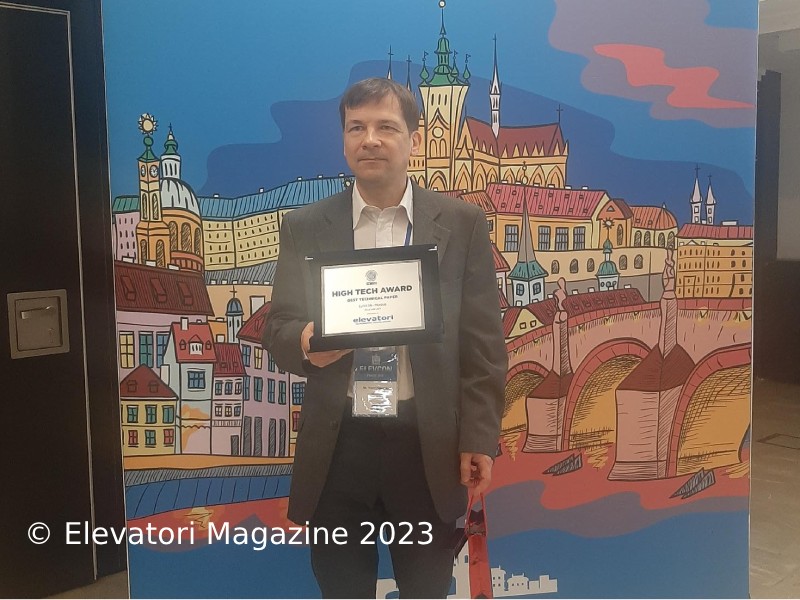
Henri Hakonen, winner of ʻHigh Tech Award Elevatori-Elevconʼ 2023

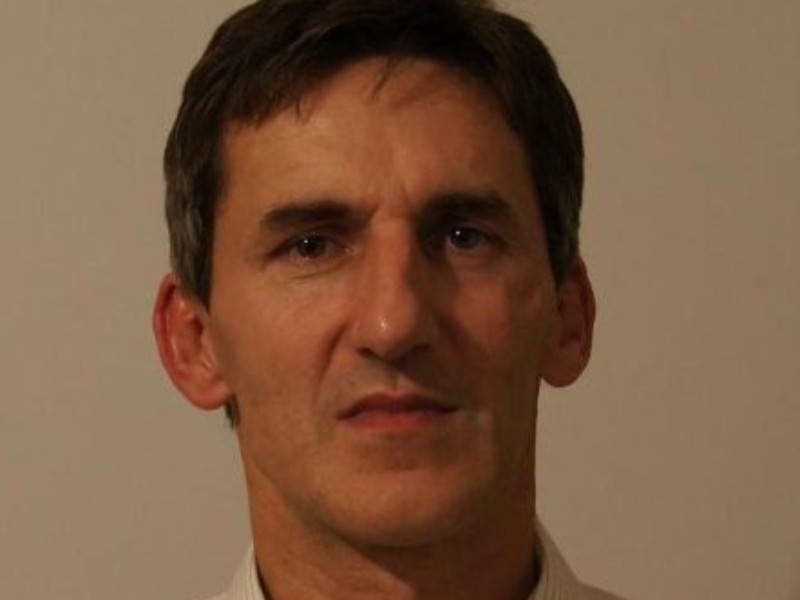
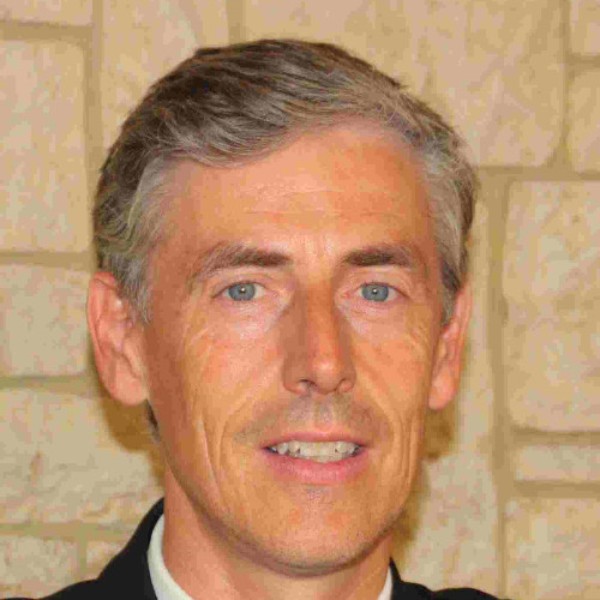
Seiji Watanabe joined Mitsubishi Electric Corp. in 1995 after receiving a Ph.D. in Mechanical Engineering from Osaka University. He is a research engineer in mechanical dynamics, particularly for the elevator industry. He is currently a senior researcher at the Advanced Technology R&D Center.
Ivan Bozic is Head of lab at ZVD (Slovenia). Ivan ins the Head of the Centre for Technical Safety and Safety Expert at ZVD Zavod za varstvo pri delu d.d. (Institute for Safety at Work), where he has worked since 1995.
Pascal Rebillard, PhD, joined Otis in 1991.
He is a “Technical Fellow” for Elevator Systems area of expertise. He is located in France. (Otis).
The Elevcon 2023 event
Elevcon 2023, the 23rd International Congress of the International Association of Elevator Engineers (IAEE), kicked off on 20 June. This edition of the conference of experts from the world of vertical transportation organised by IAEE is being held in Prague, the capital of the Czech Republic, at the Grandior Hotel, a newly designed hotel perfectly located in the centre of Prague.
Elevcon 2023, which combines a congress and an exhibition of industry innovations, runs for three days, from 20 to 22 June 2023.
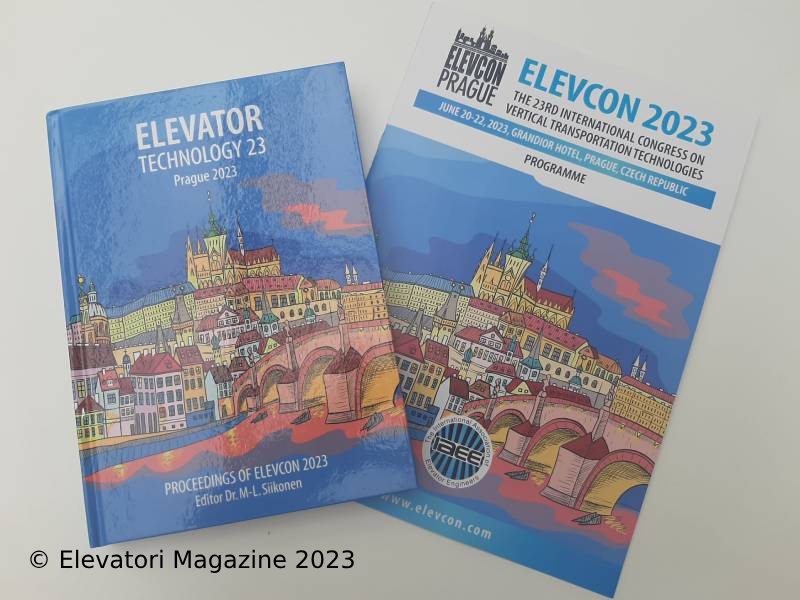
Elevcon 2023 – Open speach by Marja-Liisa Siikonen (If you do not see the video correctly, watch it here
Elevcon 2023 – Open speach by Gil Stier (If you do not see the video correctly, watch it here)
DAY ONE – 20 JUNE 2023
SESSION 1: ELEVATOR COMMUNICATION AND INFORMATION SYSTEMS
Chairperson: Dr. Stefan Gerstenmeyer, Global Cluster Lead, Traffic and Group Control
R & D, TK Elevator, Germany
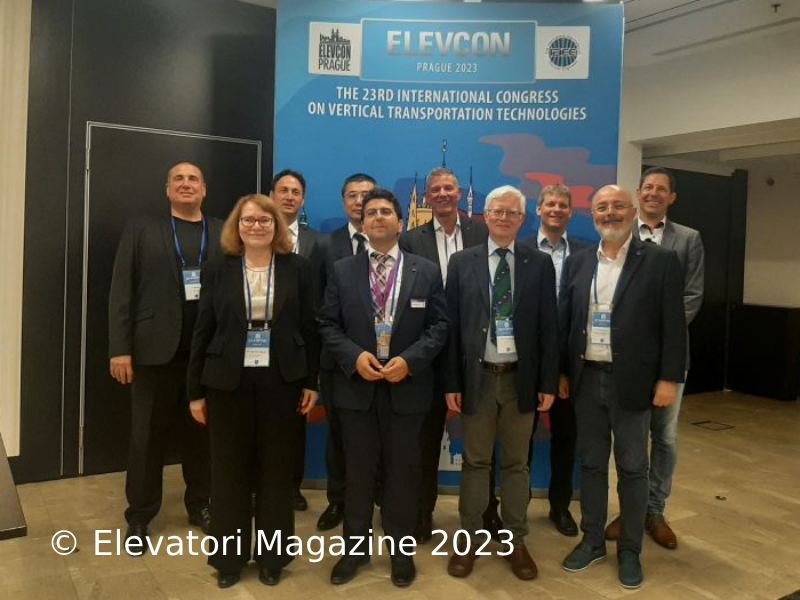
In the front row Marja-Liisa Siikonen (Elevcon 2023 Chairwoman & Programme Manager) with speakers on the first day at Elevcon 2023
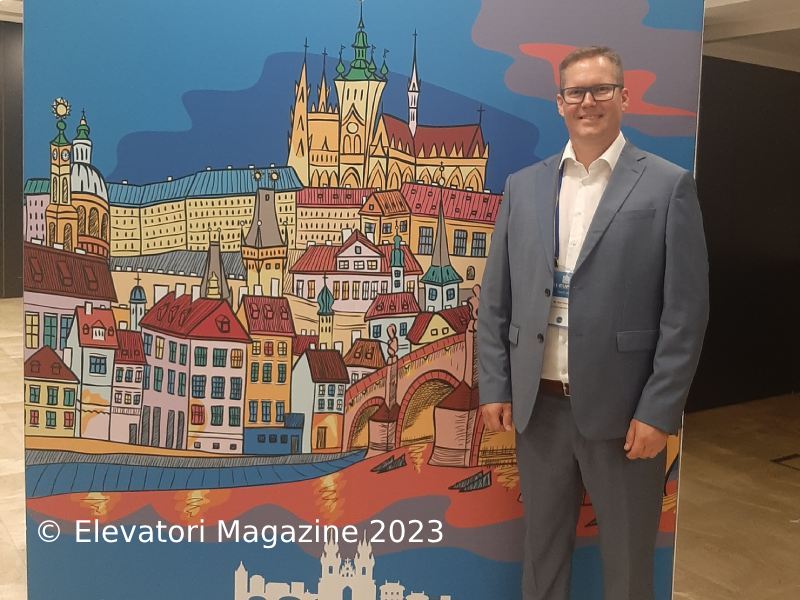
The first speaker, Petr Chovanec (2N Telekomunikace a.s)
1 – FUTURE OF ELEVATOR EMERGENCY COMMUNICATION AFTER TRADITIONAL FIXED LINES, 2G AND 3G NETWORKS SUNSET
SUBJECT: Emergency, security, communication, monitoring
AUTHOR: Petr Chovanec, 2N Telekomunikace a.s
PRESENTING: Petr Chovanec, 2N Telekomunikace a.s
COUNTRY: Czech Republic
Architecture and basis of current emergency communication systems in elevators are built on obsolete analogue technology and do not provide options how to keep up with ever demanding regulations.Elevator industry must embrace modern IP technology which will open new possibilities how elevators are operated, managed, and maintained. Shutdown of 2G and 3G should serve as an accelerator for the transition to IP. In addition, using Voice over IP (VoIP) technology for voice transmission will provide more reliable DTMF signal processing and offer a much broader feature set. Thanks to multimedia support you can also easily transmit video and text information along with voice. With IP and modern cloud infrastructure you can manage millions of devices from central place securely. You will have a full control over your systems, all configuration changes, upgrades, and new features will be installed without necessity to train have any specific IP know-how your people and travel on-site.
2 – IOT TAKES THE ELEVATOR WORLD INTO INDUSTRY 5.0
SUBJECT: Communication, IoT,COP Common operating system
AUTHOR(S): Christian-Erik Thöny, CEDES Group, Science Park, 7302 Landquart
PRESENTING: Christian-Erik Thöny, CEDES Group, Science Park, 7302 Landquart
COUNTRY: Switzerland
IoT has been enabled in the last very few years by powerful cloud systems. Almost no limits in bandwidth and data transfer rates allow “real-time” condition monitoring & controlling. The health, safety and yield of an e.g., hotel vertical transportation system, or simple single elevator application, will be significantly different to the pre-IoT aera. The consistent connected machinery generates “real-time” life data which continuously ensure shortest door open-close cycles, early detects wrong trends of a sub-system, warns of potentially dangerous situations and helps optimizing energy consumption. AI thereby distinguishes between problem causing sub-systems and components. That’s all a decisive contribution to a new aera of PLM and finally Sustainability – Industry 5.0. The origin of all such analysis and finally intelligent conclusions are sensor fusions; the micro (eco)system, the WSN – wireless sensor networks; the macro (eco)system and finally the total network of everything – the IoT COP, the IoT common operating system.
´Ubiquitous development of IoT technologies is inevitably altering the world of elevators, a quantum leap for system utilization and yield.
SESSION 2: ELEVATOR AND SHAFT COMPONENTS
Chairperson: Prof. Dr.-Ing. Mazen Ayoubi, Head of Research and Innovation, PohlCon GmbH, Germany
3 – THE SIMULATION OF SEISMIC EFFECTS ON GUIDE RAIL FASTENERS AND RE-DESIGN OF BRACKETS
SUBJECT: Shaft componentis, bracket design, simulation, earthquake, seismic
AUTHOR(S): Abdülmelik Sancak1, Adem Candaş1, C. Erdem İmrak1, Sefa Targıt2, 1ITU Elevator Technologies Laboratory, Istanbul, Turkey, 2ASRAY, Gebze/Kocaeli, Turkey
PRESENTING: C. Erdem İmrak, ITU Elevator Technologies Laboratory
COUNTRY: Turkey
ABSTRACT: In public buildings such as hospitals, universities, schools, people and equipment that need to be evacuated after an earthquake can be hardly transported.The brackets that connect and secure the elevator car and counterweight rails to the walls of the concrete elevator shaft are damaged as a result of the seismic waves. Hence, elevators cannot be used because the car and counterweight of the elevator cannot run on the rails. Critical buildings such as hospitals, public and equipment that need to be evacuated after an earthquake can be hardly transported. In this study, simulations were conducted to determine the effect of earthquake loads on the bracket parts. Finally, bracket elements were re-designed to withstand earthquake loads to use the elevator after being affected.
4 – FINITE ELEMENT ANALYSIS OF GLASS PANELS WITH BOLTED CONNECTIONS DESIGNED FOR A RUNNING CAR
SUBJECT: Elevator Cab, Point Fixed Laminated Glass
AUTHOR(S): Eren Kalay1, C. Erdem Imrak1 and Adem Candas1, 1 ITU, Elevator Technologies Laboratory
PRESENTING: Prof. Erden Imrak, ITU, Elevator Technologies Laboratory, Turkey
COUNTRY: Turkey
ABSTRACT: Nowadays, there is a growing trend towards increasing the transparency of buildings. With the developing technology now it is possible to see this trthe end in lift sector also. Increasing glass industry has revealed the term structural glass, which consists of two tempered pieces of glass with the layer of PVB. Designers have created four point fixed glass facade system for lifts with using the structural glasses to increase aesthetic view. But fixed holes create stress concentration that could lead to catastrophic failures. The aim of this paper is to investigate stress distribution around the drilled holes of lift’s glass facade while running.
5 – EVALUATION OF ELEVATOR´S CAR FLOOR USING ADHESIVE BONDING
SUBJECT: Elevator Component, Strength Evaluation, Adhesion
AUTHOR(S): Akira Nagao*, Takashi Abe*, Katsuhiro Shimada*, Tomoki Kariya, Akihiro Yamaguchi 2 , and Satoshi Ihara 2 , 1Hitachi Building Systems Co., Ltd., Japan, 2 Hitachi Ltd., Japan
PRESENTING: Mr. Akira Nagao, Hitachi Building Systems Co., Ltd., Japan
COUNTRY: Japan
ABSTRACT: In recent years, mobility industry is applying adhesion technology to improve vehicle body rigidity, ride comfort and simplify structure of components. In elevator, car floor is main structure that contributes to rigidity of car and affects ride comfort. By applying adhesion technology to car floor components, aim to increase rigidity of entire car and simplify parts configuration. In this study, we selected adhesive with high long-term reliability, used CZM analysis (Cohesive Zone Model) simulating peeling of adhesive structure, as adhesive strength evaluation and applied strength evaluation method that considers fatigue stress. This report shows the evaluation method for above contents.
SESSION 3: SAFETY COMPONENTS
Chairperson: Prof. Erdem Imrak, ITU Elevator Technologies Laboratory, Istanbul, Turkey
6 – SELECTION CRITERIA FOR SAFETY COMPONENTS – BASED ON ELEVATOR BRAKES FOR TRACTION MACHINES
SUBJECT: Traction Machine Design, Brakes and Safety Components
AUTHOR(S): Alexander Hutler, Mayr Power Transmission, Mauerstetten
PRESENTING: Mr. Alexander Hutler, Key Account Manager Elevator Brakes, Chr. Mayr GmbH + Co. KG, Germany
COUNTRY: Germany
ABSTRACT: For more than 30 years, the company Mayr power transmission has been a successful innovator in the area of elevator brakes. The reliable solutions from Mauerstetten / Germany have proven themselves thousandfold in the field – all over the world. The elevator brakes with their unique noise damping system have thus also contributed significantly to the company’s 125-year success story.
The following paper intends to illustrate not only how the requirements for elevator brakes have changed over the years, but also which requirements are still essential today and which brake solutions for elevator traction machines have already been developed to meet them.
Based on many years of experience as a manufacturer of safety brakes (including multiple global projects for leading OEMs in the industry), the paper aims to summarize the key factors that need to be taken into consideration when selecting safety components today (here based on type-tested elevator brakes) lease.
7 – The state-of-the-art and future of safe shaft information systems
SUBJECT: Electronic Sensors, EN Standards, Safety Components, Overview
AUTHOR: Dr.-Ing. Stephan Rohr, ELGO Batscale AG
PRESENTING: Dr.-Ing. Stephan Rohr, Chief Technology Officer, ELGO Batscale AG, Liechtenstein
COUNTRY:Liechtenstein
With the introduction of PESSRAL in the European Standard the future of safety systems started to be part of elevators. The absolute positioning device gets a more and more important role on that because with a safe position and speed a lot of the SIL rated functions can be implemented. To mention some: Unintended car movement, terminal slow down, inspection supervision and a lot more. This paper gives an overview of the safety functions which are available on the market
and an outlook of electronic safety functions for elevators.
8 – COMPARE STUDY ON THE PERFORMANCE OF ACOUSTIC INSULATION ELEMENT FOR GUIDE RAIL CONNECTIONS USING ANCHOR CHANNELS WITH CHANNEL BOLTS
SUBJECT: Testing, Acoustical Impairment, Noise and Vibration to The Shaft
AUTHOR(S): Mazen Ayoubi1 and Sacha Aobotta1, PohlCon GmbH, Berlin
PRESENTING: Prof. Dr.-Ing. Mazen Ayoubi, Head of Research and Innovation PohlCon GmbH, Germany
COUNTRY: Germany
ABSTRACT: The resulting operational noise of elevators can be an acoustical impairment to the usability of rooms in the vicinity of the elevator shaft. The available technological efforts to acoustically insulate elevator components are not able to prevent significant transmission of noise and vibration to the elevator shaft walls. The JORDAHL Acoustic Insulation element (JAI) is designed to decouple the transmission chain of noise and vibration, and so to prevent the vibro-acoustic transmissions reaching the elevator wall and building structure. Compare study on the performance of this element using acoustic tests taking into account the other nowadays available elements and solutions have been carried on different types of JORDAHL Acoustic Insulation. The most important scientific and practical results of the investigations will be summarized and discussed.
9 – ENHANCING ESCALATOR SAFETY WITH OPTICAL-FIBER SENSING TECHNOLOGY
SUBJECT: Safety, Monitor, Escalator, Computer Vision
AUTHOR(S): William T.W. Au1, K.C. Cheng2, W.H. Chung2, 3, Y.K. Yu3, and H.Y. Tam
1The Electrical and Mechanical Services Department, Government of the Hong Kong Special Administrative Region of the People’s Republic of China (HKSAR), Hong Kong, 2Avaron Technologies Limited
PRESENTING: Prof. Hwa-Yaw Tam, The Hong Kong Polytechnic University, HKSAR, Hong Kong
COUNTRY: Hong Kong, China
ABSTRACT: Reliable and safe operation of escalators is vital for every metropolitan city. Sensing systems making use of optical-fibers can effectively and reliably monitor the operation conditions of in-service escalators to alert any impending equipment failures or breakdowns, capable of giving advance notices for corrective measures to enhance reliability and availability of the installation. The innovative optical-fiber sensing and data analytic approach capable of early identification of faults, including brake malfunction, step dislocation due to jamming of foreign objects, defective step rollers and handrails has been demonstrated. Abnormal noise signatures of an escalator in a metro-station have been recorded and analyzed to signify impending failures of escalator components, thus enabling early rectification of the defective parts and eliminating of passenger injury or equipment damage due to failure of defective components. Coupled with artificial intelligence, the system forms an effective predictive maintenance system to reduce escalator downtime and to eliminate unnecessary inspections to realize cost savings over traditional time-based preventive maintenance.
SESSION 4: WORKSHOP 1
10 – How to Setup Safety Devices in an Elevator
Authors: Stephan Rohr 1, Christopher Bormann 2, 1 ELGO Batscale AG, Liechtenstein, 2 ELGO Electronic
GmbH, Germany
Presenting: Dr.-Ing. Stephan Rohr, Chief Technology Officer. ELGO Batscale AG, Liechtenstein
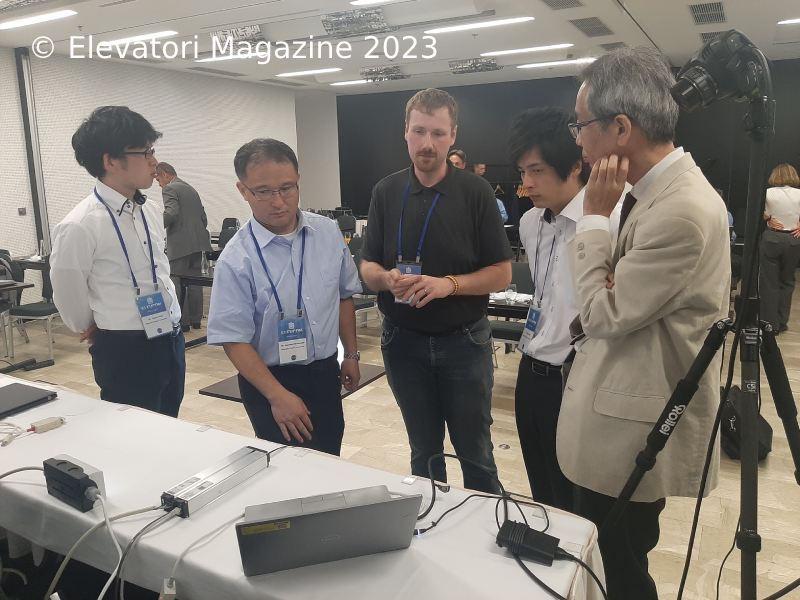
DAY TWO- 21 JUNE 2023
SESSION 5: MODERNIZATION AND RIDE COMFORT
Chairperson: Dr. Albert So, International Association of Elevator Engineers (HK-China Branch), Visiting
Professor in Lift Engineering Faculty of Arts, Science & Technology, University of Northampton, UK
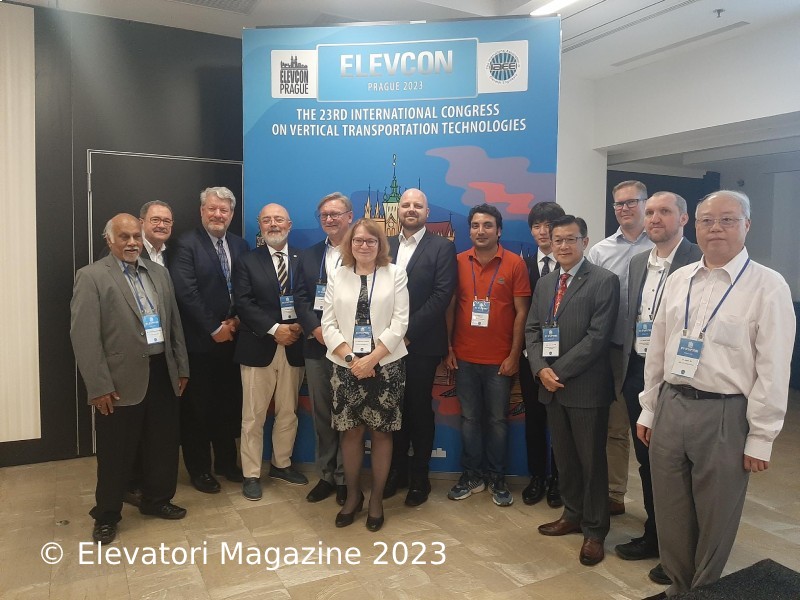
The panel of speakers on the second day of Elevcon 2023
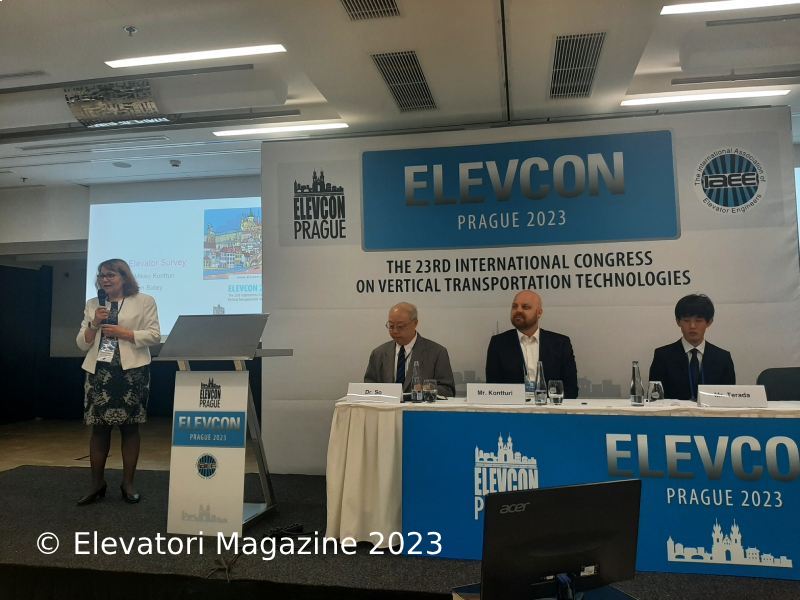
11 – Digital Elevator Survey – Improving Modernization Site Surveys
Subject: Modernization, Site Survey, Method
Author: Mr. Darren Batey, Kone Industrial Ltd., Finland
Presenting: Mr. Mikko Kontturi, People Flow Planning Expert, KONE Industrial Oy, Finland
Country: Finland
ABSTRACT: An accurate site survey is the first step in creating a successful engineered modernization. In the past site surveys have used tape measures and pen and paper, this has recently been changed to use laser measurements and mobile devices but basically the process has remained the same – just the media has changed. For complex projects KONE have started to use 3D scanning to improve the site survey accuracy, minimize disruption to our customers, improve the safety of our personnel and increase overall productivity of the engineering.
12 – Estimation of Parameters Affecting Ride Comfort in Elevators
SUBJECT: Ride Comfort, Regression Analysis
AUTHORS: Keisuke Terada, Yoshitake Kamijo, and Yoshiyuki Iwata, Toshiba Infrastructure Systems & Solutions Corporation
PRESENTING: Mr. Keisuke Terada, Toshiba Infrastructure Systems & Solutions, Japan
COUNTRY: Japan
ABSTRACT: Among the demands for energy saving and high efficiency improvement of equipment, comfort is required as added value. Vibration and noise during elevator travel propagate into the car, which induces a feeling of ear blockage and car shaking. As a result, the ride comfort, which is one of the comforts, is reduced. In this paper, we focus on the ride comfort of the elevator. We combine human subjective evaluation and objective evaluation by physical quantity to extract parameters that affect ride comfort. As a method, each index is extracted by multivariate analysis of sensory evaluation data and physical evaluation data, and they are subjected to multiple regression analysis to make association. As a result, this paper shows that the parameter to be affected is longitudinal acceleration of the human being.
13 – Elevator Wire Ropes Inspection: Regulations, State of the Art, Statistics
SUBJECT: Rope Inspection, Objective Analysis, Testing
AUTHORS: Bruno Vusini, Daniel Rossi, Tommaso Bertani, AMC Instruments
PRESENTING: Dr. Bruno Vusini, Managing Director, AMC Instruments, Italy
COUNTRY: Italy
ABSTRACT: The traction cables of lifts play a very important role in the safety of people. Only in Italy we have about 900,000 working lifts, which make an average of more than 1 million trips per day. This means that millions of people rely on the proper operation, and maintenance, of all the components of this particular (and let’s say intrinsically safe) machine. There are, of course, laws and standards that must correctly regulate the maintenance operations that allow the elevator to operate as correctly and safely as possible, and it is often taken for granted that the maintenance technicians operate in total accordance with these documents. International standards, such as the ISO4344, require the identification of very little damages that are really difficult to be visually identified and for this reason a real rope visual inspection takes hours to be completed.
Fortunately, technology is advancing and, concerning rope analysis, much more efficient inspection methods have appeared on the market in the last 10 years.
The purpose of this article is to provide basic information about the inspection market, laws and standards, and the results obtained over a period of more than ten years, from which both the advantages of using advanced methods, and the total inefficiency of antiquated analysis methods are evident.
SESSION 6: ELEVATOR GROUP CONFIGURATION AND DESIGN
Chairperson: Mr. Raymond Spiteri, Managing Director, TVI Services Ltd. (Malta)
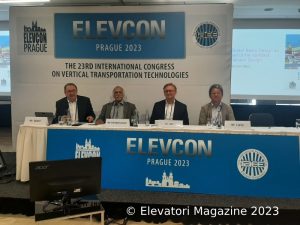
14 – Divider Beam Design as Part of The Standard Elevator Design
SUBJECT: Elevator Group Configurations, Divider Beam, Modular System, Design Standard, Quality Control
AUTHOR: Michael Merz, Hilti Corporation, Principality of Liechtenstein
PRESENTING: Dr. Sc.techn. Michael Merz, Competence Manager, Hilti Corporation, Principality of Liechtenstein
COUNTRY: Principality of Liechtenstein
ABSTRACT: Divider beams can create headaches for project managers who must provide separation walls in a hoistway that should host two or more elevators. To avoid accidents during the handling and welding of heavy steel material, the installation of the beams is often passed to the general contractor or a subcontractor. Involving a third party requires design drawings, a bidding process, coordination, inspection for acceptance and, finally, the complaint procedure. This paper introduces a new design method for installing divider beams as part of the elevator installation process and discusses the multiple benefits of this innovative solution.
15 – Design Challenges in Asia due to Manufacturers’ Differences
SUBJECT: Optimal Elevator Design, Space, Consultant
AUTHOR: K. Rajah Venkatraman, Vinay Venkatraman, Fortune Consultants, India
PRESENTING: K. Rajah Venkatraman, Vinay Venkatraman, Fortune Consultants, India
COUNTRY: India
ABSTRACT: The designer/developer faces many challenges in providing space for vertical transportation. For example, often floor plates and high density become limiting factors for VT Design. Additionally, in Asia, different suppliers/manufacturers have their design constraints which calls for different dimensional and other requirements varying between each other. These and other differences between VT types are the challenges listed as major difficulties in achieving optimal design. To strengthen this argument and to look for a commonality between the suppliers, various segments are being presented in the paper touching upon the various aspects of VT Design.
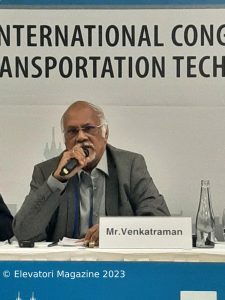
16 – Multifunctional Lift Design for Slender Luxury Residential Towers
SUBJECT: Elevator Design, Dual Cars, Multifunctional
AUTHOR: Hongliang Liang, Aliang Lift Design Studio Ltd, UK
PRESENTING: Mr. Hongliang Liang, Vertical Transportation Consultant, Aliang Lift Design Studio Ltd, UK
COUNTRY: UK
ABSTRACT: The author developed two unique methods for vertical transportation design, called ´Disadvantage Transformation´ and ´Time Space Deployment´. By using these methods, the author has successfully delivered three VT system designs for all kind of high-rise residential towers. This paper introduces the second design which was also inspired by the VT design in the Shard, London: the lift looks similar to a double-deck lift, but the loading into the two cars would never happen simultaneously. At peak times, the lower car of a time-sharing lift works as a passenger lift under destination group control at low-rise front lobbies. At off-peak times, the upper car works as a simplex service lift in independent mode at fire-protected rear lobbies whilst also working as a firefighting/evacuation lift at rear lobbies at any time by activating the relevant switches.
SESSION 7: MAINTENANCE AND CONDITION MONITORING
Chairperson: Mr. Sefa Targit, Vice President, MAKFED Turkish Machinery Federation, Turkey
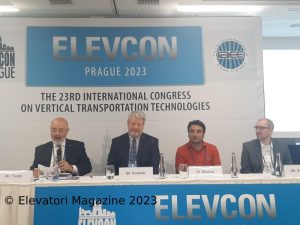
17 – Vertical Equipment Maintenance
SUBJECT: Maintenance, ASME Standard, Tasks
AUTHOR: John W. Koshak, QEC, CEI eMCP, LLC – Managing Member, USA
PRESENTING: Mr. John W. Koshak, QEC, CEI eMCP, LLC, Managing Member, USA
COUNTRY: USA
ABSTRACT: The Safety Code for Elevators and Escalators in the United States and Canada, ASME A17.1/CSA B44, includes Section 8.6, the Maintenance, Repair, Replacement and Testing section. It applies to all new and existing equipment to ensure maintenance is performed on critical components of vertical equipment to reduce hazard. It prescribes a Maintenance Control Program (MCP), a documented set of maintenance tasks, procedures, examinations, tests and records to ensure that equipment is maintained in compliance with the requirements of Code. It requires establishing the intervals between performing a maintenance task, recording maintenance performed, recording repairs, replacements, alterations, call backs, oil loss, and several other items. Authorities Having Jurisdictions in the United States and Regulatory Authorities in Canada (AHJs/RAs) require owners to provide and follow MCPs. This paper details the Code and a system that fully complies with these requirements, eMCP.
18 – Condition Monitoring of Elevator Using Deep Learning and Frequency Analysis Approach
SUBJECT: Maintenance, Predictive, False Alarms, Fault Data
AUTHOR: Krishna Mohan Mishra1, John-Eric Saxen2, Jerker Bjorkqvist2, and Kalevi J. Huhtala1, 1Unit of
Automation Technology and Mechanical Engineering, Tampere University, Tampere, Finland, 2Department
of Information Sciences, Abo Akademi University, Turku, Finland
PRESENTING: Dr. Krishna Mishra, Unit of Automation Technology and Mechanical Engineering, Tampere
University, Tampere, Finland
COUNTRY: Finland
ABSTACT: In this research, we propose automated deep learning feature extraction technique to calculate new features from fast fourier transform (FFT) of data from an accelerometer sensor attached to an elevator car. Data labelling is performed with the information provided by maintenance data. Calculated features attached with class variables are classified using random forest algorithm. We have achieved 100% accuracy in fault detection along with avoiding false alarms based on new extracted deep features, which outperforms results using existing features. This research will help various predictive maintenance systems to detect false alarms, which will in turn reduce unnecessary visits of service technicians to installation sites.
19 – Automatic Detection of Objects Blocking Elevator Doors Using Computer Vision
SUBJECT: Elevator Monitoring with Computer Vision, Detect Objects
AUTHOR: David Baumgartner1, Ignace Jordens2, Daniel Wilfing3, Oliver Krauss4, Dorfmeister1, Gerald
Zwettler1, 1University of Applied Sciences Upper Austria – Research Group Advanced Information System
and Technology (AIST), Austria, PXL University of Applied Sciences and Arts, Belgium, 3VIEW Promotion
GmbH (Ltd)
PRESENTING: Mr. Gerald Zwettler, Senior Researcher, University of Applied Sciences Upper Austria, Advanced
Information System and Technology (AIST), Austria
COUNTRY: Austria
ABSTRACT: In this paper, we present a new approach applying computer vision methods to image data acquired with depth perception cameras to map the interior of the elevator, detect the position and the state of the door and to detect objects in the door area. The depth data is used to determine the elevator cabin as a safety cube, i.e., the position of the door, layout of the elevator, and so on, while color data further enhances the detection of new objects. The approach can detect the state of the elevator door as either opened or closed, while no object is blocking the view to the door, as well as successfully identify objects blocking an open door. This elevator monitoring proves to be relevant for the determination of the elevator state, safety as well as aspects of predictive maintenance.
SESSION 8: WORKSHOP 2
20 – Reverse Engineering – Remote Monitoring of Elevators and Authorised Third-Party Access to Elevator Data
AUTHOR: Esko Kilpinen, Modusolutions, Finland
PRESENTING: Mr. Esko Kilpinen, Modusolutions, Finland
COUNTRY: Austria
ABSTRACT: In this paper, we present a new approach applying computer vision methods to image data acquired with depth perception cameras to map the interior of the elevator, detect the position and the state of the door and to detect objects in the door area. The depth data is used to determine the elevator cabin as a safety cube, i.e., the position of the door, layout of the elevator, and so on, while color data further enhances the detection of new objects. The approach can detect the state of the elevator door as either opened or closed, while no object is blocking the view to the door, as well as successfully identify objects blocking an open door. This elevator monitoring proves to be relevant for the determination of the elevator state, safety as well as aspects of predictive maintenance.
THIRD DAY – 22 JUNE 2023
SESSION 9: ELEVATOR PLANNING AND SIMULATION
Chairperson: Mr. Robert Nicholson, President, Architectural Elevator Consulting, LLC, USA
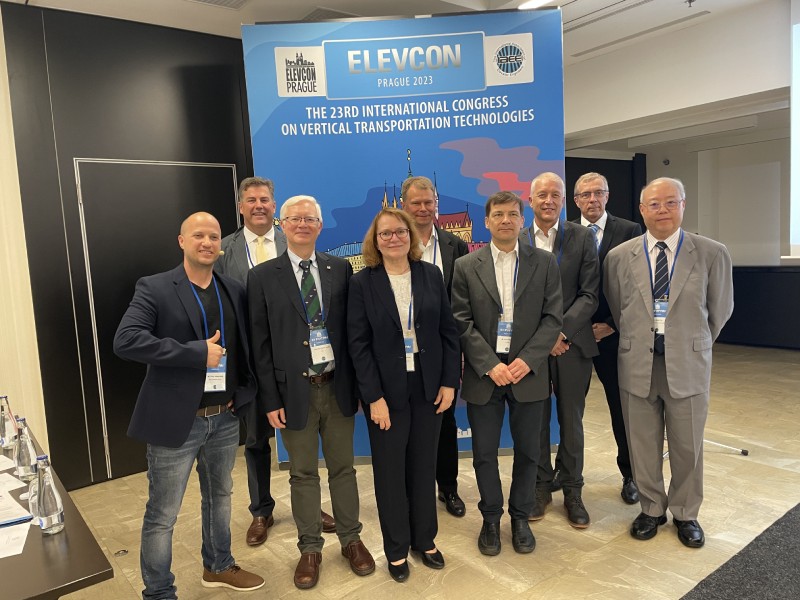
The panel of speakers on the third day of Elevcon 2023
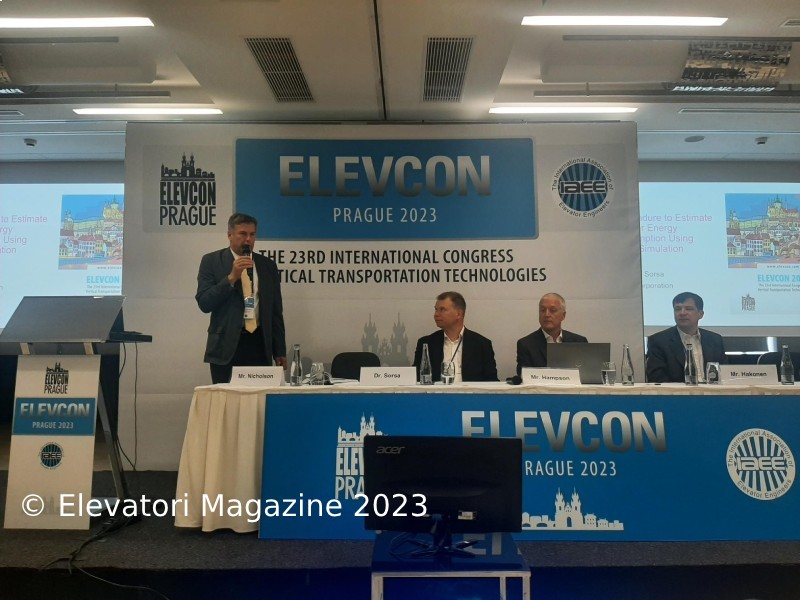
21 – A Procedure to Estimate Elevator Energy Consumption Using Elevator Traffic Simulation
SUBJECT: Elevator, Energy Consumption, Simulation
AUTHOR: Janne Sorsa, KONE Corporation, Finland
PRESENTING: Dr. Janne Sorsa, D.Sc. (Tech), KONE Corporation, Finland
COUNTRY: Finland
ABSTRACT: Current methods estimate the annual energy consumption of an elevator using simplifying modelling assumptions. The assumptions, however, may greatly differ from elevators operating in groups in high-rise buildings under complex traffic conditions and intensive use. For such cases, elevator traffic simulation provides an accurate method to evaluate energy consumption per typical day in operation. This article describes a procedure to first simulate a typical daily passenger demand profile and then to evaluate energy consumption from elevator trips occurring in simulation. In addition, numerical examples show how the procedure can be applied in practice to compare different elevator products.
22 – Vertical High Schools – The Future of Failure?
SUBJECT: Elevator Design, High Schools, Case Study
AUTHOR: Scott Hampson, Arup, Australia
PRESENTING: Mr. Scott Hampson, Vertical Transportation Leader, Arup, Australia
COUNTRY: Australia
ABSTRACT: Vertical schools are becoming a necessity in growing and crowded cities and can range from 4 floors to 20 floors and up to 2000 students. With the complexities of building population, passenger demands and height, vertical schools present multiple technical challenges for the vertical transportation engineer. Arup was engaged to deliver a vertical transportation solution for a large vertical high school in Sydney Australia and our challenge was to meet the performance requirements of stakeholders while also being considerate of spatial and cost constraints. My paper reviews the full life cycle of the project and covers our design approach, client engagement, challenges, solutions, final operation, and lessons learned.
23 – Simulation Based Design of Transportation Systems in Buildings
SUBJECT: Elevator and Escalator Design, Traffic, Simulation
AUTHOR: Henri Hakonen, Lic.Sc. (Tech) & Juha-Matti Kuusinen, D.Sc. (Tech), and Janne Sorsa, D.Sc. (Tech), KONE Corporation, Finland
PRESENTING: Mr. Henri Hakonen, Lic.Sc. (Tech), KONE Corporation, Finland
COUNTRY: Finland
ABSTRACT: This paper describes some key advances in modelling and simulating people flow in buildings including multiple transportation and access devices such as elevators, escalators, staircases, turnstiles and doors. The flow consists of autonomous agents whose routes through the building depend on their physical and behavioural characteristics such as walking speed, the ability to use certain devices and preference about different route alternatives. These computational simulation models have been combined with game engine technology to develop a new simulation tool called the People Flow Simulator enabling realistic agent movement, high-quality 3D visualizations and easier assessment and communication of the simulation results for the design of better functioning buildings.
24 – Evacuation Lift Standardization
SUBJECT: Evacuation, EN and ISO Standards
AUTHOR: Ari Kattainen, KONE Technology and Innovation, Finland
PRESENTING: Mr. Ari Kattainen, Leading Expert, Codes and Standards, KONE Technology and Innovation, Finland
COUNTRY: Finland
ABSTRACT: Lifts may be used during evacuation of a building when building ensures safe operating environment. Lifts may be the only quick egress method for persons having disabilities even in low rise buildings and in high rise buildings lifts may reduce evacuation time significantly. This document explains status of international standardization of lifts which may be used for evacuation of a building. Document compares different evacuation operation functions which are specified in published standard documents CEN/TS 81-76, ISO/TS 18870, ASME A17.1 / CSA B44 and CEN prEN 81-76. Document introduces potential use cases of different evacuation operation modes for different types of buildings and for different size and type of population.
25 – Enhancement of Auto-Recovery Function for Elevators After Earthquake
SUBJECT: Seismic Detectors, Self-Diagnostics, Auto Recovery
Author: Shohei Kondo, Shuichi Hayakawa and Junji Takeda, Toshiba Elevator and Building Systems Corporation, Japan
Presenting: Mr. Shohei Kondo, Toshiba Elevator and Building Systems Corporation, Japan
COUNTRY: Japan
ABSTRACT: Toshiba Elevator and Building Systems Corporation has already commercialized an auto-recovery function for elevator systems that is activated by an earthquake, performing a self-diagnosis to tentatively restore elevators to normal service. We have now enhanced this system by positioning seismic detectors in order to measure seismic waves directly for comparison with the seismic design criteria of the equipment. In the case of a tremor smaller than the seismic design standard, the new system facilitates the provision of a field service for temporary and safe restoration of the elevator if the automatic self-diagnosis operation detects no anomaly.
26 – A Field Study on the Damage of Elevators After the Twin Earthquakes
SUBJECT: Hazard, Earthquake, EN 81-77
AUTHORS: Ferhat Çelik1, C. Erdem Imrak2, and Sefa Targıt3. 1Blain Hydraulic GmbH, Heilbronn, Germany, 2ITU Elevator Technologies Laboratory, 3ASRAY, Turkey
PRESENTING: Mr. Sefa Targıt, General Manager of ASRAY and Vice President of MAKFED, Turkey
COUNTRY: Turkey
ABSTRACT: The elevators are widely utilized for vertical transportation of people and goods in buildings. In many recorded earthquake events in the past, a considerable number of damages in elevators were observed. There is a considerable stock of elevators in the seismic risk zones of Turkey. Any building in a seismic risk area should be designed to withstand the earthquake shocks. In this study, after a one-day field study conducted by AYSAD in and around Malatya after the twin earthquakes, an evaluation of the damages detected in the examined elevators and the current situation was included.
ʻHigh Tech Award Elevatori-Elevconʼ
WINNER: Henri Hakonen, Lic.Sc. (Tech.), Juha-Matti Kuusinen, D.Sc. (Tech.), and Janne Sorsa, D.Sc. (Tech) KONE Corporation, Finland. “Simulation Based Design of Transportation Systems in Buildings” – Accepts the award Henri Hakonen (in the picture here below)
PRESENTING: Presenting: Eng. Matteo Volpe, Editor, Elevatori Magazine, Italy
The ʻHigh Tech Award Elevatori-Elevconʼ is the prize for the best presentation of the congress: not an easy task given the very high technical and scientific standard of the papers. The winner has been selected by a prestigious jury comprising representatives of Elevconʼs scientific committee, including the IAEE president and Matteo Volpe (our editor).
ʻHigh Tech Award Elevatori-Elevconʼ: The award ceremony (IF YOU DO NOT SEE THE VIDEO CORRECTLY, WATCH IT HERE)
27 – Elevators On the Moon Are Closer Than You Think – Vertical Transportation Space Era
SUBJECT: Elevator, Space and Moon Environment
AUTHORS: Yuval Valiano-Rips1, Maya Glickman-Pariente2, 1Rips Elevators Group (Rips Engineering Ltd), Israel, 2SPACECIALIST Ltd, Israel
PRESENTING: Mr. Yuval Valiano-Rips, Rips Elevators Group, Rips Engineering Ltd, Israel
COUNTRY: Israel
ABSTRACT: Few space programs have already been initiated and funded to take humans to the moon, Mars and beyond, the major one being Artemis Mission that is set on building inhabited base camps, for science and mining, on the lunar surface.
Taking huge amounts of equipment down from a 50m high landers, traveling to the underground camps or mines, all require us to reimagine elevators in the harsh environment of space.
This is not science fiction- the first elevators will be operational on the moon during the expected landing of SpaceX landers by the end of this decade, under the Artemisprogram.
In our paper, we have researched the challenges for this new market, and proposed a roadmap for upgrading the elevator industry to the space era. This paper is a call for action for our industry.
28 – A Brief History of Multidirectional, Rope-less Elevator Systems
SUBJECT: Ropeless, Vertical and Horizontal Movement History
AUTHORS: Dr. Lee E. Gray, The University of North Carolina at Charlotte, USA
PRESENTING: Dr. Marja-Liisa Siikonen, CEO, MLS Lift Consulting Ltd. & Elevcon 2023 Chairwoman & Programme Manager , Finland
COUNTRY: USA
ABSTRACT: Every profession embraces a set of elusive goals that constitute what may be thought of as “Holy Grail” projects. For the vertical transportation industry this includes the search for an elevator system that moves passengers vertically and horizontally. The contemporary search for this Holy Grail suggests that an historical overview could provide a useful lens through which to understand current events. This paper explores a variety of proposed solutions to ropeless, multi-direction elevator systems.
29 – Study on Linear Permanent Magnet Synchronous Machines for Ropeless Lifts
SUBJECT: Ropeless, Hoisting Systems, Simulation, Power Consumption, Power Failure
AUTHORS: Albert So1 and W.L. Chan2, International Association of Elevator Engineers (HK-China Branch), 1University of Northampton, 2The Hong Kong Polytechnic University, UK, Hong Kong
PRESENTING: Dr. Albert So, International Association of Elevator Engineers (HK-China Branch), Visiting Professor in Lift Engineering Faculty of Arts, Science & Technology, University of Northampton, UK
COUNTRY: UK, Hong Kong
ABSTRACT: It is rather certain that multi-dimensional lift systems will soon dominate the lift industry in coming years due to the first successful development of MULTITM. To facilitate such a design, the concept of ropeless lifts has to be implemented while the adoption of linear permanent magnet synchronous machines (LPMSMs) such as those used in the MULTITM system is an obvious choice. Without the existence of hoisting ropes, lift cars not only can travel along all three directions, but the number of which in one hoistway is not limited to two. We carried out a series of academic studies to evaluate the performance of such LPMSMs under various conditions by simulation. In this paper, which is a summary of our previous works with some new input, the control method to realize the required kinematics under a full-load up journey, the impact of different electrical parameters on the power consumption, and most important, the analytical solution associated with emergency operation under a genuine power failure will be discussed. Machine models of surface mounted and salient permanent magnets will also be considered. This is basically a review paper based on a series of previous publications of the authors.










